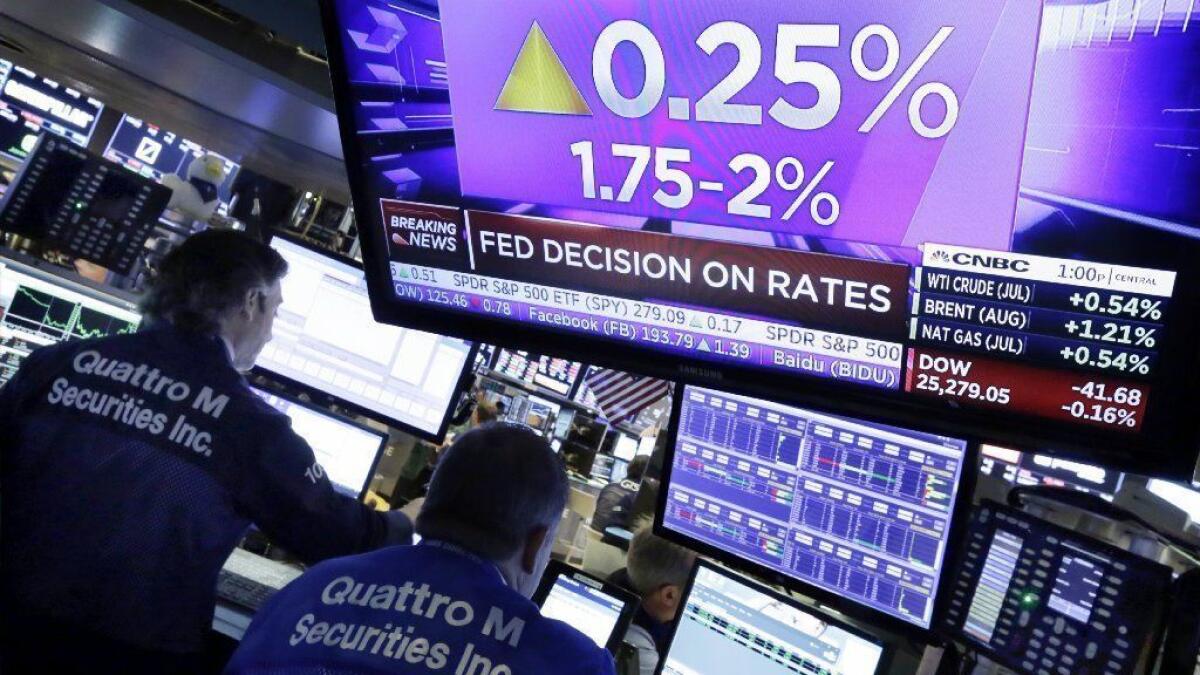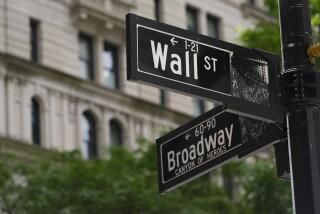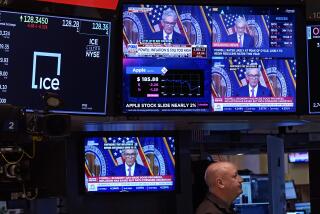Higher interest rates are spurring a subtle shift to cash investments. But don’t expect to get rich

- Share via
Cash is creeping back.
With interest rates rising and the stock market cooling from its big gains last year, some savers and investors are placing more money into once-dormant cash-related products such as money market funds, bank certificates of deposit and Treasury securities.
The net assets of money market mutual funds totaled $2.89 trillion as of June 6, the highest level since the financial crisis in 2008-09, according to the Investment Company Institute, a mutual-fund trade group.
At Vanguard Group, one of the nation’s largest mutual fund providers, net cash flows into money market funds totaled $10.5 billion in the first four months of this year — nearly twice the $5.3-billion inflow during the same period last year — to $238 billion.
Still, that’s by no means a massive shift. And a spot check of financial planners and wealth management advisors in Southern California showed all were keeping roughly the same amount of cash as a percentage of their clients’ portfolios, a percentage that’s typically in the single digits because most of the money is invested in stocks and bonds.
The rise in rates is “just not enough to change the equation at this point,” said Stuart Blair, director of research at Canterbury Consulting, a Newport Beach firm that manages $18.5 billion of assets.
Money funds and other cash-related products were paid scant notice during the last decade because they paid so little, carrying interest rates not much above zero. That largely was due to the Federal Reserve Board’s stimulus monetary policy, in which it kept its benchmark short-term rates at nearly zero to help the country recover from the financial collapse.
As the U.S. economy bounced back, the stock market enjoyed a nine-year bull run that continues today — the Dow Jones industrial average has soared nearly threefold since early 2009 — and investors were disinclined to keep much money in cash.
That was true even for the middle class, which poured most of its money — including 401(k) retirement money — into stock mutual funds rather than low-yielding money funds.
But the scenario changed starting in December 2015, when the Fed began nudging interest rates higher once again. The central bank has done so several times since then — most recently on June 13, when it lifted its key rate to a range of 1.75% to 2% — and two more hikes are expected this year.
In response, yields on a variety of fixed-income “cash” products rose as well.
The yield on the widely held 10-year Treasury note stood at 1.43% two years ago; today it’s nearly 3%.
The average yield on five-year bank CDs was 1.24% as of May 30, up from 0.78% in 2013, though some institutions offer five-year CDs with yields above 2%, according to Bankrate.com.
At the same time, the bull market in stocks stalled. After plunging 10% over two weeks in January and February, the benchmark Standard & Poor’s 500 index has regained only some of that ground; on Thursday, the Dow Jones industrial average closed down for the eighth straight trading day. Bond yields, near historic lows two years ago, have been rising steadily. (Yields move in the opposite direction of prices.)
“Interest rates are rising, valuations on riskier assets like stocks are elevated, and investors are starting to rethink their willingness to take risks in pursuit of returns as cash becomes more appealing,” said Greg McBride, Bankrate.com’s chief financial analyst.
With CDs in particular, “momentum has certainly picked up in the last nine months,” he said.
CDs, money-market funds, Treasury bills and other short-term, liquid accounts are in large part about protecting one’s assets — often with a fixed return — rather than risking them on the vagaries of the stock and bond markets.
That safety feature largely took a back seat while the stock market kept setting record highs. So the shift to cash now is primarily because cash-related products simply are paying more than they have in years.
“For the first time in more than a decade, CD investors are getting a return that is on par or better than inflation,” McBride said.
But barely. The Federal Reserve’s latest projection is that inflation will move up to 2.1% this year. That means “on a real [inflation-adjusted] basis you’re still losing money” with many cash instruments that yield less than 2.1%, Blair said.
Other factors besides the Fed’s monetary policy have fueled the heightened interest in cash.
As stock prices have wobbled amid rising trade tensions between the United States and other nations, investors poured $55 billion into worldwide money market funds in the week that ended June 6, the highest since October 2013, according to the research firm EPFR Global.
Blair said another reason cash levels have swelled is simply because stock prices have risen so high in recent years. That has raised the overall value of portfolios and, because money managers maintain a certain percentage of those portfolios in cash, they’ve had to add more dollars to the cash portion of those portfolios.
Consider, for example, a $1-million portfolio that keeps 5%, or $50,000, in cash. As stock gains lifted the portfolio’s value to $1.5 million, the portion invested in cash instruments had to climb to $75,000 to maintain that 5% level.
“You haven’t changed your risk profile, but on an absolute basis the cash portion has gone up,” Blair said.
Despite the recent uptick, returns on cash-related investments remain paltry compared with past decades.
When interest rates soared in the 1970s and ‘80s, CDs and T-bills carried double-digit yields. They fell back into the single digits in the 1990s as investors’ attention turned to the stock market, which soared during the ‘90s until the dot-com crash in 2000, recovered and then was flattened again by the Great Recession of 2008-09.
Tony Cherin, a finance professor emeritus at San Diego State, thinks one reason savers and investors are looking at cash instruments despite the paltry rates is the drop in the U.S. jobless rate and this year’s federal tax cuts. The two are combining to provide extra cash for people who might not be comfortable with the inherit risk in the stock and bond markets and instead like the security of a CD or money fund.
“Unemployment is extremely low now, so more people have cash in their pockets,” Cherin said. “If you’re relatively uneducated in the area of investments, what do I do? I’ll buy a CD or maybe a money market fund.”
Their goal is to preserve the cash they do have, especially if they’re trying to pay down credit card or school debt, he said.
Blair said the trend also reflects individual investors who are trying to time the stock market — that is, move some money from stocks to cash until they see the stock market moving higher again.
“It’s the retail investor taking more money off the table and more likely trying to time the market,” Blair said. He added that’s usually a mistake, because it’s tough to guess the market’s next moves.
“The data we have suggests that very few can get this right on a consistent basis,” Blair said. If one shifts money from stocks to cash, he said, “then you have to figure out when to get back in again.”
Twitter: @PeltzLATimes
More to Read
Inside the business of entertainment
The Wide Shot brings you news, analysis and insights on everything from streaming wars to production — and what it all means for the future.
You may occasionally receive promotional content from the Los Angeles Times.











